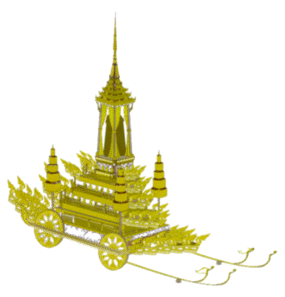

The old avenues of Bangkok will be graced once more by golden palanquins and chariots in the Procession of the Royal Urn of HRH the Princess Mother to the crematorium site at Sanam Luang.
The main funeral vehicles will be the 201-year-old Great Funeral Chariot (Phra Maha Phichai Ratcharoth) and the Supreme Patriarch's Carriage (Ratcharoth Noi). The Great Funeral Chariot, the symbol of the King, is a royal vehicle that is perceived as a manifestation of his divine status, adopted in former years to instil fear and so increase the monarch's might.
The earliest evidence of the use of the Royal Chariot in royal ceremonies is found in the Ayutthaya Period. The vehicle was used not only in royal funeral processions as at present, but also to tour the city after coronations or, as the Ayutthaya Kingdom developed relations with foreign nations, for carrying royal documents to envoys.
A total of 216 soldiers in four groups draw special ceremonial chariot, also known as the Phra Maha Phichai Ratcharoth. Built around 1795 during the reign of King Rama 1, it is 11.20 metres tall and 15.30 metres long.
It has been used as a Royal Bier, and to convey the remains of Somdej (Prince) Phra Pathom Borom Mahachanok, father of King Rama I, to the cremation ground at Sanam Luang in 1796.
Later, during the reign of King Rama VI, it was refurbished, with wheels added to help support its weight. The chariot was completely restored in 1987.
This ornate vehicle was built during the reign of King Rama I and was used as the chariot of the Supreme Patriarch. Like the Phra Maha Phichai Chariot, it was used in the procession for the funeral of the father of King Rama I in 1796.
A Royal Palanquin is a wheel-less vehicle consisting of a sedan chair and two poles, designed to be carried by human bearers. In earlier times it was part of the royal regalia denoting the monarch's rank, and was used for travelling to ceremonies or informal occasions.
There is evidence that Royal Palanquins were in use at least as early as the Lop Buri Period. They were first mentioned during the Ayutthaya Period. Thai Royal Family Law, issued in AD 1459 in the reign of King Boromtrailokanat, makes it clear that palanquins were used only by the Royal Family and the nobility.
This large, elaborate vehicle is used to transport the Roval Urn. It is made of teakwood, carved, gilded and d with small mirrors. The palanquin, and side supports, is home on three better distribution of weight. It needs two shifts of60 bearers to support its weight.
A similar palanquin was used to carry the remains of King Chulalongkorn from Dusit Palace to the Grand Palace on October 24, 1910.
Materials from Bangkok Post